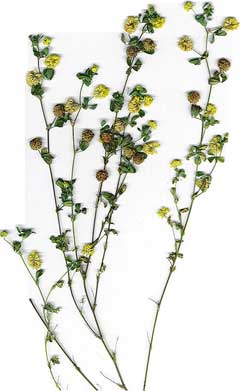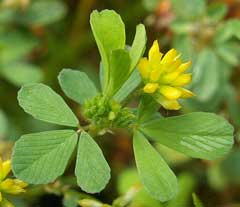 |
|
www.hear.org/starr/ |
 |
| commons.wikimedia.org/wiki/User:Kenraiz |
Translate this page:
Summary
Physical Characteristics

 Trifolium dubium is a ANNUAL growing to 0.5 m (1ft 8in).
Trifolium dubium is a ANNUAL growing to 0.5 m (1ft 8in).
It is not frost tender. It is in flower from May to October, and the seeds ripen from July to October. The species is hermaphrodite (has both male and female organs) and is pollinated by Bees. The plant is self-fertile.
It can fix Nitrogen.
It is noted for attracting wildlife.
Suitable for: light (sandy), medium (loamy) and heavy (clay) soils, prefers well-drained soil and can grow in nutritionally poor soil. Suitable pH: mildly acid, neutral and basic (mildly alkaline) soils. It cannot grow in the shade. It prefers moist soil.
UK Hardiness Map
US Hardiness Map
Synonyms
T. minus. Sm.
Plant Habitats
Lawn; Meadow;
Edible Uses
References More on Edible Uses
Medicinal Uses
Plants For A Future can not take any responsibility for any adverse effects from the use of plants. Always seek advice from a professional before using a plant medicinally.
The plant is haemostatic[257]. A poultice of the chopped plant has been applied to cuts to stop the bleeding[257].
References More on Medicinal Uses
The Bookshop: Edible Plant Books
Our Latest books on Perennial Plants For Food Forests and Permaculture Gardens in paperback or digital formats.

Edible Tropical Plants
Food Forest Plants for Hotter Conditions: 250+ Plants For Tropical Food Forests & Permaculture Gardens.
More

Edible Temperate Plants
Plants for Your Food Forest: 500 Plants for Temperate Food Forests & Permaculture Gardens.
More

More Books
PFAF have eight books available in paperback and digital formats. Browse the shop for more information.
Shop Now
Other Uses
References More on Other Uses
Cultivation details
Succeeds in a moist, well-drained circum-neutral soil in full sun[200]. Succeeds in poor soils[200]. Grows well in a wild flower lawn[200]. It grows well in an apple orchard, the trees will produce tastier fruit that stores better[201]. It should not be grown with camellias or gooseberries because it harbours a mite that can cause fruit drop in the gooseberries and premature budding in the camellias[201]. The nectar-rich flowers are a good food source for bees and butterflies[200]. This species has a symbiotic relationship with certain soil bacteria, these bacteria form nodules on the roots and fix atmospheric nitrogen. Some of this nitrogen is utilized by the growing plant but some can also be used by other plants growing nearby[200]. Buttercups growing nearby depress the growth of the nitrogen bacteria by means of a root exudate[201]. When removing plant remains at the end of the growing season, it is best to only remove the aerial parts of the plant, leaving the roots in the ground to decay and release their nitrogen.
References Carbon Farming Information and Carbon Sequestration Information
Temperature Converter
Type a value in the Celsius field to convert the value to Fahrenheit:
Fahrenheit:
The PFAF Bookshop
Plants For A Future have a number of books available in paperback and digital form. Book titles include Edible Plants, Edible Perennials, Edible Trees,Edible Shrubs, Woodland Gardening, and Temperate Food Forest Plants. Our new book is Food Forest Plants For Hotter Conditions (Tropical and Sub-Tropical).
Shop Now
Plant Propagation
Pre-soak the seed for 12 hours in warm water and then sow in spring to early summer in situ.
Other Names
If available other names are mentioned here
Native Range
TEMPERATE ASIA: Cyprus, Israel, Turkey, Russian Federation-Ciscaucasia (Ciscaucasia) EUROPE: Denmark, United Kingdom, Ireland, Norway, Sweden, Czechoslovakia, Austria, Belgium, Switzerland, Germany, Hungary, Netherlands, Poland, Russian Federation (European part), Belarus, Lithuania, Latvia, Ukraine (incl. Krym), Former Yugoslavia, Albania, Bulgaria, Greece, Italy (incl. Sardinia), Romania, Spain, France (incl. Corsica), Portugal AFRICA: Morocco, Tunisia
Weed Potential
Right plant wrong place. We are currently updating this section.
Please note that a plant may be invasive in one area but may not in your area so it's worth checking.
Conservation Status
IUCN Red List of Threatened Plants Status :

| Related Plants
|
| Latin Name | Common Name | Habit | Height | Hardiness | Growth | Soil | Shade | Moisture | Edible | Medicinal | Other |
| Trifolium bifidum | Piñole Clover, Notchleaf clover | Annual | 0.5 |
0-0
| | LMH | N | M | 2 | 0 | 3 |
| Trifolium ciliatum | Foothill Clover | Annual | 0.5 |
0-0
| | LMH | N | M | 2 | 0 | 3 |
| Trifolium cyathiferum | Cup Clover | Annual | 0.5 |
0-0
| | LMH | N | M | 1 | 0 | 2 |
| Trifolium dichotomum | Branched Indian Clover | Annual | 0.6 |
0-0
| | LMH | N | M | 2 | 0 | 2 |
| Trifolium fimbriatum | Springbank Clover, Cows clover | Perennial | 1.0 |
0-0
| | LMH | N | M | 3 | 0 | 2 |
| Trifolium fucatum | Sour Clover, Bull clover | Annual | 0.6 |
0-0
| | LMH | N | M | 2 | 0 | 2 |
| Trifolium fucatum virescens | | Annual | 0.6 |
0-0
| | LMH | N | M | 2 | 0 | 2 |
| Trifolium gracilentum | Pin-Point Clover, Palmer's clover | Annual | 0.6 |
0-0
| | LMH | N | M | 2 | 0 | 2 |
| Trifolium hybridum | Alsike Clover | Perennial | 0.6 |
0-0
| | LMH | N | M | 2 | 1 | 2 |
| Trifolium incarnatum | Crimson Clover | Annual | 0.5 |
3-9
| M | LMH | N | M | 2 | 0 | 4 |
| Trifolium lupinaster | Lupine clover | Perennial | 0.5 |
0-0
| | LMH | N | M | 1 | 0 | 2 |
| Trifolium macrocephalum | Bighead Clover, Largehead clover | Perennial | 0.3 |
4-8
| | LMH | N | M | 1 | 0 | 3 |
| Trifolium microcephalum | Smallhead Clover | Annual | 0.6 |
-
| | LMH | N | M | 1 | 0 | |
| Trifolium obtusiflorum | Clammy Clover | Annual | 1.0 |
0-0
| | LMH | N | M | 2 | 0 | 2 |
| Trifolium ornithopodioides | Birdsfoot Fenugreek, Bird clover | Annual/Perennial | 0.2 |
0-0
| | LMH | N | MWe | 1 | 0 | 3 |
| Trifolium pratense | Red Clover | Perennial | 0.6 |
5-9
| M | LMH | N | M | 3 | 3 | 4 |
| Trifolium repens | White Clover, Dutch Clover, Purple Dutch Clover, Shamrock, White Clover | Perennial | 0.1 |
4-8
| M | LMH | N | M | 3 | 2 | 4 |
| Trifolium subterraneum | Subterranean Clover | Annual | 0.2 |
7-10
| | LMH | N | M | 1 | 0 | 4 |
| Trifolium tridentatum | Tomcat Clover | Annual | 0.6 |
0-0
| | LMH | N | M | 2 | 0 | 2 |
| Trifolium variegatum | Whitetip Clover | Annual | 1.0 |
-
| | LMH | N | M | 1 | 0 | |
| Trifolium wormskioldii | Cow clover | Perennial | 1.0 |
5-9
| | LMH | N | MWe | 3 | 0 | 0 |
|
Growth: S = slow M = medium F = fast. Soil: L = light (sandy) M = medium H = heavy (clay). pH: A = acid N = neutral B = basic (alkaline). Shade: F = full shade S = semi-shade N = no shade. Moisture: D = dry M = Moist We = wet Wa = water.
Now available:
Food Forest Plants for Mediterranean Conditions
350+ Perennial Plants For Mediterranean and Drier Food Forests and Permaculture Gardens.
[Paperback and eBook]
This is the third in Plants For A Future's series of plant guides for food forests tailored to
specific climate zones. Following volumes on temperate and tropical ecosystems, this book focuses
on species suited to Mediterranean conditions—regions with hot, dry summers and cool, wet winters,
often facing the added challenge of climate change.
Read More
Expert comment
Author
Sibth.
Botanical References
17200
Links / References
For a list of references used on this page please go here
Readers comment
© 2010, Plants For A Future. Plants For A Future is a charitable company limited by guarantee, registered in England and Wales. Charity No. 1057719, Company No. 3204567.